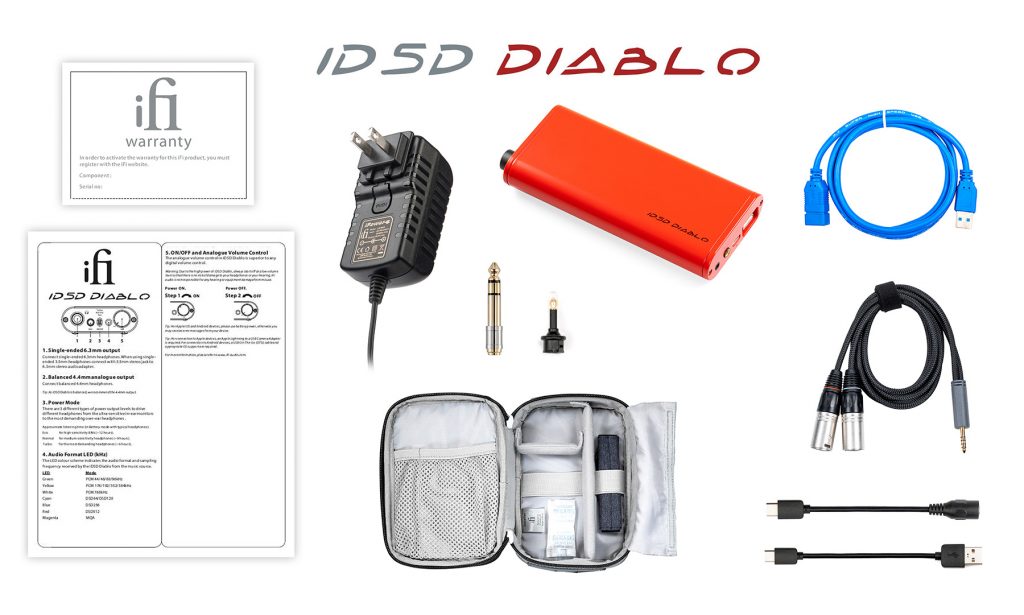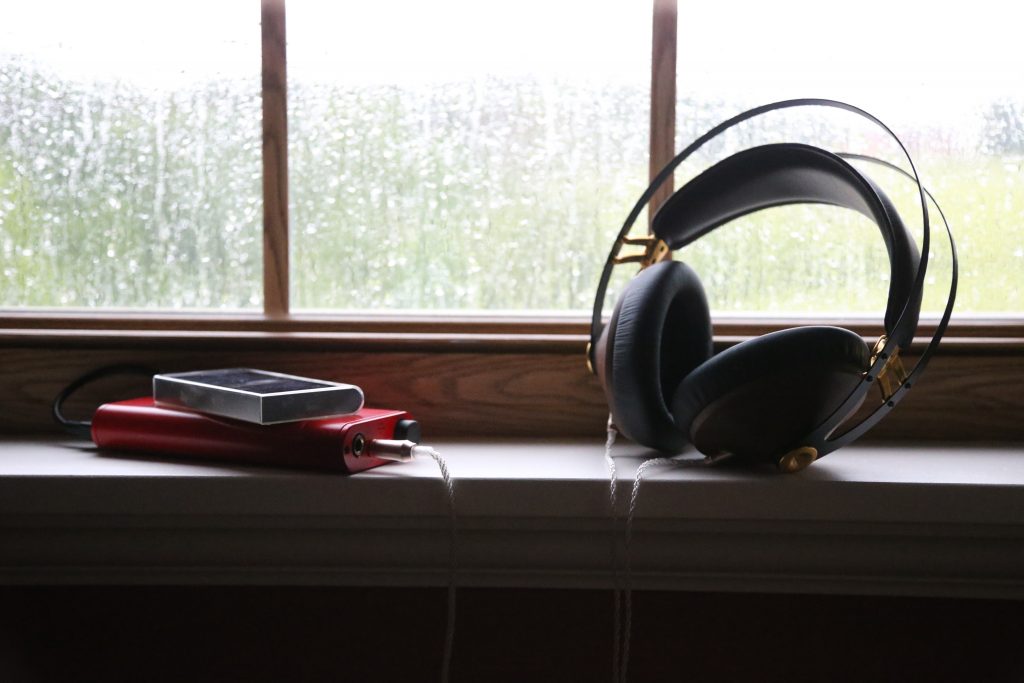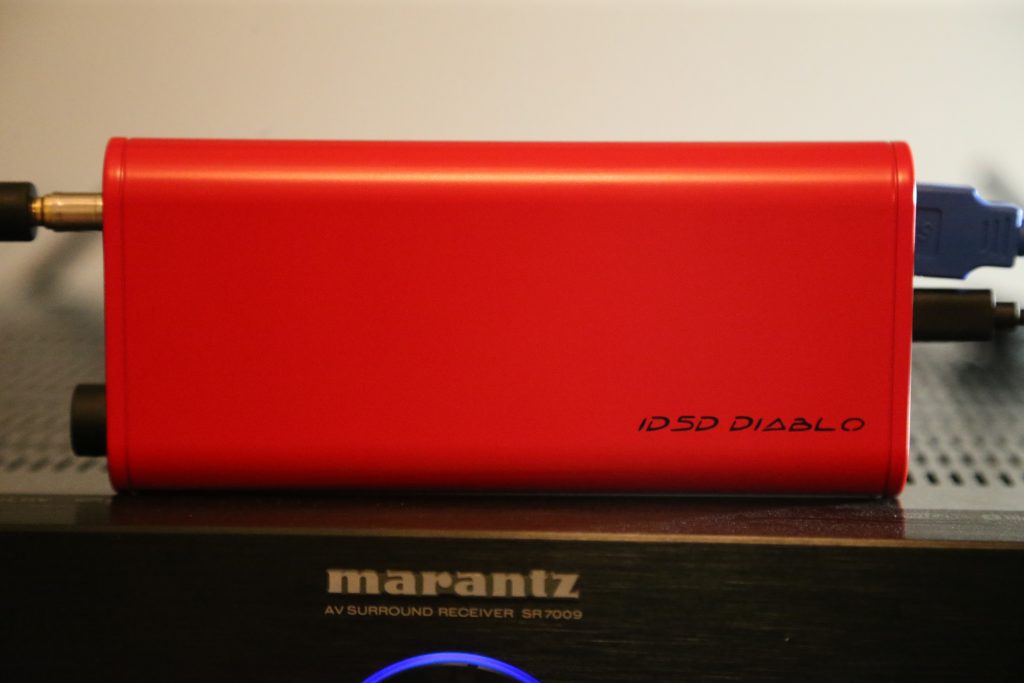Ifi Audio has sent over another piece of kit for us to check out, this time it is the iDSD Diablo. We expected this DAC/Amp to be a beast with a name like Diablo and the bright red coloring, we expected this DAC/Amp to be a beast. For 899.99 U.S. Dollars, this portable HiFi is not cheap, though not overly expensive either. That’s right, the Diablo is portable, with a built-in battery you take it anywhere they let batteries go (pretty much everywhere I think). Though I suppose some restrictions apply, such as water, probably don’t try to swim with the Diablo, or it may give up the ghost. In the box with the Diablo is a convenient case that will hold the diablo and your source be it a phone or just about any other portable playback device with a digital output. I don’t have one of the old portable CD players anymore, so I did not try to fit it in the mesh back. You can also keep your charging cables and other accessories in the carry case. I personally didn’t try to walk around with the case and use it as I tend not to do that type of listening, I did however like to use it to keep my gear together when I would head into the office. Let’s head deep down and see if the Diablo lives up to its name.

Getting Set up and Accessories
Getting your Diablo ready to go is s about as simple as possible. Step one; plug it into the wall with the included charger, plug the USB cord into it and your device and hook up headphones. You’ve done it, you set up the Diablo, once you get that taken care of, take a quick nap because step two will take you hours. Step two; turn on the Diablo and listen to music. You will notice on the front that there is a little switch with ECO, Normal, and Turbo, this is basically a gain switch you set depending on how hard to drive your headphones are. If you are using IEM’s ECO is plenty of power, got a set of HD600’s you will want turbo mode. You have some options as well for connecting headphones and or, but not limited to, a preamp, There is a 1/4 inch socket on the front for non-balanced output, as well as an included adapter down to 3.5mm non-balanced. Next to that, you have a balanced 4.4mm socket as well as another on the back. When I connected the Diablo to the Michi X5 with the included XLR cables I used the back one as it was easier to do so.
Also in the box you will find the manual, though you probably don’t need it. As well as a couple of USB C adapters, one to USB type A, and one to connect to the power brick. Next you also have a female to male USB type A 3.0 cable to use with your laptop. iFi also sent me on of their USB noise filters, the iPurifier3. I do not believe this is normally an included accessory as it is not listed as such on their website. I will say the iPurifier is not something that did much for my system as the Fiio and my Macbook Pro have pretty clean USB signals, however, you may notice a difference with other devices. It should be noted that if I set my phone on top of my Fiio M9 some noise would come through the line, that would not with the iPurifier, so perhaps a use case if you put all your devices in the carry case together. If your source device is fairly isolated it may not be a necessity for you, but if you have multiple devices especially with Bluetooth, WIFI, and other signals you may want to look into it. We may do a little review on it where we try to put it in all types of scenarios to see what it can handle.

Diablo’s Sound
The important part right? How does it sound? Well, it sounds great, the end. No, we wouldn’t do that to you, I put it through the paces and hooked it up to just about everything I have around here to see how it is. For the most direct comparisons, I used my Fiio M9 to play digitally into my Marantz and let it do the conversion, then I also plugged it into the Diablo and then let that do the conversion into the Marantz. This was really the best way for me to do an A/B as it was the same source and same amplification/ speakers and so on. The only thing is both devices have volume control so I did my absolute best to get it to be the same. Another comparison I did was directly out of the Fiio M9 into Meze 99 Classics as well as using the Diablo with that setup. Let’s take each comparison and discuss them further.
When comparing the internal DAC in my Marantz SR7009 and the Diablo’s DAC, the most obvious difference is the frequency extension and presence. The bass is tighter and deeper, and the highs have more of that top-end detail and sparkle so to speak. After listening to some songs I have that really show how well something images, you get a little better sense of depth and placement with the Diablo over the Marantz. I really like to listen to Funkadelic’s “Maggot Brain” and “Leave it Alone” by Caroline Glaser for this. Both of those songs have an excellent spatial presence. It is also worth noting while comparing the DAC’s I left the Marantz in Pure Direct mode for all listening. I usually won’t do that as I have it set how I like, but I feel it makes it more of an even playing field during a review. Overall, I will say I prefer the sound of the Diablo over the Marantz, though it is not a blowout win. There are times that I think a product is just far better than the competition, however, I think in the world of DAC’s you have to look a little deeper. The benefits of a certain circuit or chip may not be as obvious as a change of speakers, but they are there if you listen with intent.

The differences were less subtle when comparing the sound between my Fiio M9 and the Diablo. The Fiio M9 is a good budget DAP, it has some nice features and sounds better than most phones I have listened to over the years, including my iPhone 11 Pro. As it is a dedicated audio device we expect it to be decent and at its price, we also don’t expect it to be exceptional. My main reason for getting it was listening to CD-quality FLAC files both at home and on the go. That said there is an exceptional increase in quality by letting the Diablo handle the DA conversion and amplification. I used Meze’s 99 Classics to compare the two with headphone use. When paired with the Diablo you get much better dynamic range and detail though the headphones. 99 Classics are known for being rich and warm so getting more of that top-end detail and emphasis really balanced them out extremely well. Speaking of balanced, the Diablo has a balanced 4.4mm output which I used for the Meze’s balanced cable. The Diablo has power for the most hard-to-drive headphones so with the more sensitive 99 Classics you are nowhere near audible distortion unless you are interested in listening at hearing damaging levels. I kept the power options switch in normal mode when using the headphones as it offered plenty of power and range using the volume knob. The best part of the Diablo for me is this listening scenario as my Fiio M9 is portable as is the Diablo. With the included carry case it was very nice to take to the office and use there. The battery when on a full charge lasted a full 9 hour day for me on normal gain and about 2/3 volume at most. Obviously, this will vary for every user depending on your listening habits and paired gear.
I tested the Diablo with one other piece of equipment, the Michi X5 as I happen to have it in for review and has balanced XLR inputs, which the balanced 4.4mm to XLR is another cable you get with the Diablo. To save my fingertips a little work here is a quote from that review:
To build on the sound quality, something I found very pleasing and somewhat surprising for an integrated amp, was the DAC. I have played with a few dedicated DACs ranging from 100 bucks to over 2 grand for just a DAC. I use my FIIO m9 to play FLAC files and it has a decent DAC in it for the price and would say it’s fairly comparable to most integrated amps in sound quality. That said I did also use its digital out to the coax in on the Michi and noticed an immediate improvement in quality. With other amps, it’s been more subtle of a difference either better or worse. Out of the interest of science, I also have an iFi Diablo in for review and used it as my DAC which was closer to being the subtle difference I expected, though at nearly 1000 US for the Diablo one would expect that. When using the Diable I used the balanced output to the XLR inputs on the X5 which also has a positive effect on sound quality, whereas when using the internal DAC of the FIIO M9 I did not initially use a balanced cable, though later tried this as well and found some improvement again. I would say if your source has a digital out, I recommend trying out the Michi’s DAC, and also take advantage of the XLR input where you can for analog inputs.
– me about a month ago

That pretty much wraps up the comparisons, and overall I like the Diablo’s sound. I will also say it is my favorite product I have checked out from iFi so far. It is not necessarily the best, but the sound quality paired with mobility and simplicity make it a homerun for me. If you want flexibility in sound, inputs and features the iDSD Pro is superior, though I would not want to carry that back and forth to the office and you certainly are not going to use it on the go unless you also want to carry a hefty power bank, to be honest, I do not suggest trying that at all. The sound quality is fantastic such a compact mobile AMP and DAC, though I have come to expect that from iFI. They have a way of making amazing products, full of top-shelf components, such as Texas Instruments, for a very reasonable price. I nerd out for Texas Instruments components personally, the reason being my personal experience building a guitar amp in school as a project. I originally used cheap transistors and other components to test the circuit for functionality, then rebuilt it with all TI components and the difference was astonishing. All the noise and distortion was lifted from the circuit, so trust me all those little parts matter. All that said, ff I were to be purchasing one or the other I would probably get the Diablo as for me it offers me more solutions for the money, the same way the Fii0 M9 does over a CD transport. If you have no need for mobility shoot for the iDSD Pro for sure.
iDSD Diablo Specs
| Digital Inputs | USB 3.0 type ‘A’ (USB2.0 compatible) S-PDIF (3.5mm coaxial/optical) | |
| Formats supported | DSD512/256/128/64 Octa/Quad/Double/Single-Speed DSD DXD (768/705.6/384/352.8kHz) Double/Single-Speed DXD PCM (768/705.6/384/352.8/192/176.4/ 96/88.2/48/44.1 kHz) MQA (Decoder) | |
| Frequency Response | 10Hz-80kHz(-3dB) | |
| SNR | Balanced S-E | -120dB -114dB |
| Dynamic range | Balanced S-E | 120dB 114dB |
| THD + N | Balanced S-E | 0.002% 0.001% |
| Headphone Max Output | Balanced S-E | >19.2V/611 mW (@ 600 Ohnn) >12.6V/4,980 mW (@ 32 Ohm) >9.6V/153 mW (@ 600 Ohm) >8.8V/2,417 mW (@ 32 Ohm) |
| Fixed Audio Output | Balanced 4.4mm | |
| Power consumption | Turbo Normal Eco | 12W 5W 2W |
| Battery | Lithium-polymer 4800mAh | |
| Power System | Charging via USB-C (iFi iPower included) BC V1.2 compliant up to 1900mA charging current | |
| Dimensions | 166 x 72 x 25 mm 6.5″ x 2.8″x 1.0″ | |
| Weight | 330g (0.73 lbs) | |
| Warranty period | 12 months |

Conclusion
The Diablo is for the 99 Classic of the DAC/AMP world. It is not the world’s best option, but what is, is a balanced product. It strikes that balance of Price, Performace, and Usability. I enjoy the simplicity of its design and limited options for the user as well. Limited options may seem like a bad thing, but with a portable device, I don’t want to have to worry about a bunch of knobs and switches getting bumped and having to dial in my sound again and again. In a similar way as the Heaven 11 Billie Amp, it is nice to be able to turn it on and listen and not get lost in a maze of menus and settings, trying to squeeze out just a slightly different sound. At 899.99 US Dollars, this is not a cheap unit, however, it is worth the price to me at least. It is delivering sound quality near what I heard in a 7000 dollar Michi Amp, albeit maybe a bit different tonality. Though cheap is subjective, I generally consider any single piece nearing the 1000 dollar point to be not cheap. All in all, if you want top-tier sound quality, power, and portability, the Diablo should be on your list to check out.
For Purchasing Information head to https://ifi-audio.com/products/idsd-diablo/
Disclaimer:
iFi Audio Provided Hifi Chicken with the Diablo for use in this review, iFi Audio did not pay in part or full for this review.







